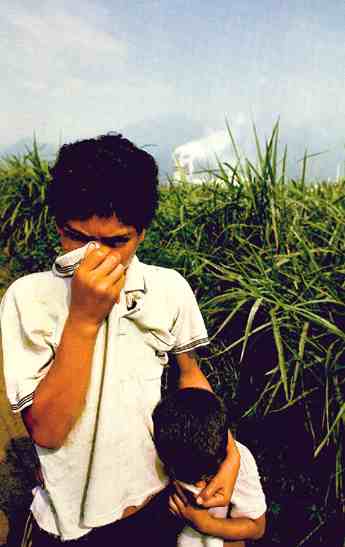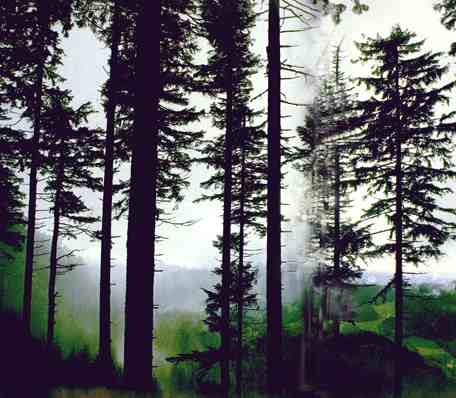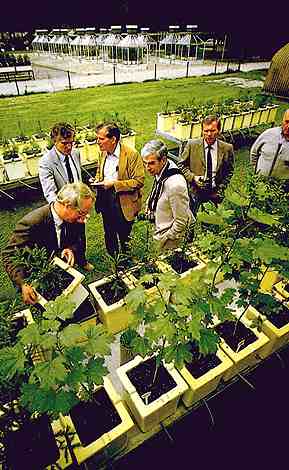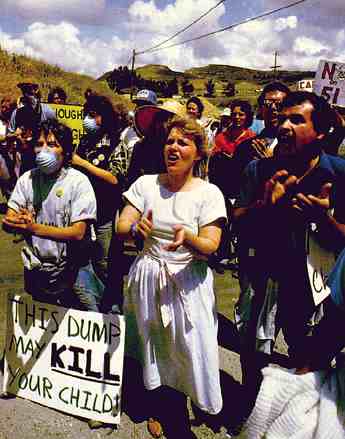
April 1987 National Geographic

Thick with sulfur dioxide, smoke belches from the 550-foot stacks of the Phelps Dodge copper smelter in Douglas, Arizona. Too old to be profitably tamed by anti-pollution devices, the 85-year-old plant was closed in January. It was a victory for the environmentlists (left) who had long protested the smelter's operation. Solutions to other air-pollution problems are not so clear.
 With
no place to hide, boys in Cubatão, Brazil, cover their faces as
they try to avoid breathing a cloud of lung-searing fumes from a fertilizer
plant. Called the "valley of death" by residents, Cubatão may be
the most polluted community on earth. Scores of plants including a petrochemical
complex pump at least 75 pollutants into its frequently stagnant air, raising
contamination levels in parts of town to twice those considered safe for
humans. "Some days it is so bad you can't breathe," says one resident.
"If you go outside, you will vomit."
With
no place to hide, boys in Cubatão, Brazil, cover their faces as
they try to avoid breathing a cloud of lung-searing fumes from a fertilizer
plant. Called the "valley of death" by residents, Cubatão may be
the most polluted community on earth. Scores of plants including a petrochemical
complex pump at least 75 pollutants into its frequently stagnant air, raising
contamination levels in parts of town to twice those considered safe for
humans. "Some days it is so bad you can't breathe," says one resident.
"If you go outside, you will vomit."
During the past two years, Sao Paulo state health officials report major reductions in particulates and other pollutants. But globally, new threats apgear as fast as known pollutants are reduced. Deadly dioxins and other toxics, identified in some fish in the Great Lakes, are believed transported by air over great distances. Pesticides and herbicides found recently in alarmingly high concentrations in fog have been added to the list of potential culprits inforest dieback.
A DEATH brought a nightmare to life for me, the kind that is difficult
to flee.Most of us have dreamed of running from some awful dread, on feet
that seem encased in leaden shoes.
I was watching a pathologist perform an autopsy on a man who had drowned
at Newburgh, New York. The lungs, when exposed, were blotchy with stiff
dark spots. "Ah," I observed, "a smoker."
"Not necessarily," said soft-spoken Dr. Torrence Payne, as he continued
unhurried incisions. "Those are deposits of carbon. Virtually everyone
has lungs like that after their mid-40s if they've lived in or near an
urban area."
Another dying, far distant, drove the nightmare home. Germans call it Waldsterben, or forest dying, in which conifers weep needles and beeches grow bald with premature aging. In January I stood on a snow-covered slope east of Cologne and looked at Norway spruces with skeletal outlines.
"Normally they shed old needles after seven years, but look at this one," said green-coated forester Dieter Deumling, pointing to an anemic specimen as we crunched across deep snow to a low, barren branch.
According to West German scientists, the trees are being stressed by air pollution. Perhaps by sulfurous clouds from power-generating smokestacks. By the breath of automobile exhausts and metallic compounds drifting from a smelter. By all of these and more, coming sometimes from hundreds of miles away and, like the carbon in human lungs, having a cumulative effect. Forests are afflicted not only in central and eastern Europe but also in Norway, Sweden, the United States, and Canada. Scientists debate the role of pollution in killing trees — how it works in conjunction with onslaughts of insects, disease, or climate changes. Most agree, however, that airborne pollutants play a significant role.

 At
a research center in Essen-Kettwig (right), visiting American scientists
inspect damage to trees exposed to ozone and acidic fog under controled
conditions in the chambers in the background. Tests so far have found no
simple cures. Says the mayor of one Black Forest village: "There is no
reason for optimism."
At
a research center in Essen-Kettwig (right), visiting American scientists
inspect damage to trees exposed to ozone and acidic fog under controled
conditions in the chambers in the background. Tests so far have found no
simple cures. Says the mayor of one Black Forest village: "There is no
reason for optimism."
In other areas dirty air is held even more culpable. Man-made monuments that have endured for thousands of years are now being rapidly eaten away. In the American West spectacular vistas are fading behind an aerosol haze. Ozone resulting from automobile emissions annually reduces crop yields significantly, sometimes by as much as 20 percent of the soybean harvest.
What is not known about air pollution may be even more disturbing. We
are in the midst of a chemical revolution in which some 65,000 commercial
compounds enter our environment each year. Some are proven carcinogens
– cancer-causing substances – and many more are suspected of being so.
Yet only eight chemicals are listed as hazardous and are regulated at their
source by the U. S. Environmental Protection Agency (EPA).

What worries protestors demonstrating at Casmalia, Califomia (right), is what they don't know. They suspect that a nearby toxic dump has flooded the town with hazardous fumes, causing headaches, scratchy eyes, and nausea.
In a quiet valley near California's coast I watched a protest rally unfold in a school yard that has been emptied several times by nauseating fumes. A mile and a half north of the little town of Casmalia, population about 200, a toxic waste dump lies hidden by rolling foothills. For several years cast-off cyanide, oil-field acids, and industrial solvents were hauled there and left in open lagoons to evaporate. Local residents began complaining of noxious smells and respiratory problems. Soon all unusual ailments loomed large in the community's consciousness-nose-bleeds, chronic diarrhea, a baby's birth defect, a young teacher's death by leukemia.
"On November 25, 1985, I had a metallic taste in my mouth and a queasy stomach," said Ken McCalip, principal of the two-teacher Casmalia Elementary School. "The other teacher told me she was too sick to teach. We dismissed for the day. "
"When the wind died and the fumes lingered in town, it kept us like prisoners in our homes," said Debra Vaudrin, who later fled with her family.
The county health office urged closing the dump. "Though we have no definitive proof that it is harmful," an official told me, "we also don't have proof that it is not. "
Dumping of liquid wastes was stopped, but the solids continued. Casmalia residents believed the county supervisors were reluctant to give up revenue -- nearly three mil- lion dollars annually -- received in fees from the dump. The supervisors answered that state law preempted them from closing it over a health issue. I called the director of state health services, Dr. Kenneth Kizer, who said, "Nobody wants toxic wastes nearby, but we have a limited number of sites in which to dispose of them. Until we get additional sites, we'll have to base our decision on the information we gather."
This past January Dr. Kizer's department decided that the dump posed no imminent danger to citizens and would remain open, although more closely monitored. "Clearly there have been problems," Dr. Kizer said, "but we need more information before closing the dump."
WHERE OUR AIR is concerned, in Casmalia as in the rest of the world, we live in an age of uncertainty. As damage from our aerial soup concerns us more and more, an alarmed public clamors for answers and action. Both are slow in coming.
For example, the Carcinogen Assessment Group (CAG), an arm of EPA, was formed in 1976 to determine what chemical substances pose high cancer risks. Out of the thousands of commercial substances released to the atmosphere, "we've reviewed the data on about 200 of them," said Dr. Roy E. Albert, former CAG chairman, "those that have been identified as possibly carcinogenic and worthy of further study."
His voice grew steely: "The record of EPA regulation is abysmal. But research is expensive, and the funding we are now getting for research is inadequate."
A filthy haze chokes Mexico City on a winter morning in 1986 (right).
Vehicle exhaust, factory smoke, and smoldering refuse heaps befoul the
air inhaled by 17 million people.
Breathing this air has been compared to smoking two packs of
cigarettes a day.
By contrast, the sky was clear in September 1985 (left) when
winds washed out the city's vast bowl-shaped valley. Even the peaks of
nearby volcanoes were visible -- a cause for celebration.
Yet the air pollution picture is not toally bleak. Continuing research
offers some hope of improvement. In late 1986 two scientists reported a
chemical process capable of eliminating nitrogen oxides from diesel exhaust
gases and coal-fired boilers. The hot gases, passed over a nontoxic chemical
called cyanuric acid, break down into harmless nitrogen and water.
If later research supports the findings, a giant step could be taken
toward eliminating a major contributor to acid rain and man-made ozone.